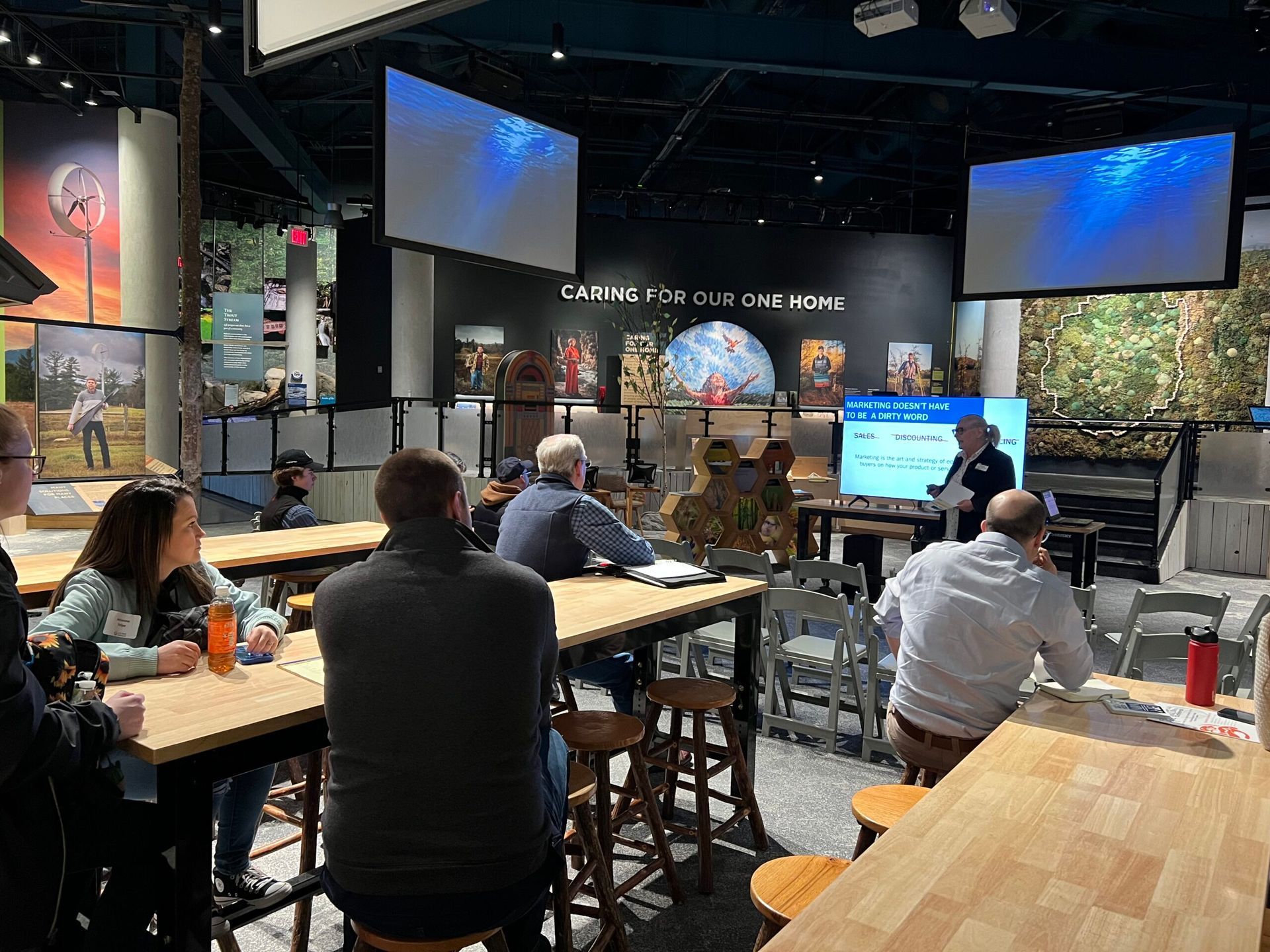Adirondack Common Ground Alliance
2024 Blueprint for the Blue Line
For Governor’s staff, commissioners, senior agency staff, legislative leaders, and legislative staff
On Oct. 20, 2023, the Adirondack Common Ground Alliance held its annual forum at Gore Mountain, attracting nearly 200 stakeholders. The forum focused on identifying solutions for multiple issues important to the region and New York state. For the first time in the forum’s history, these conversations were preceded by a series of panel discussions organized by the Adirondack Association of Towns and Villages (AATV).
This 2024
Blueprint for the Blue Line is a summary of recommendations for state action to benefit the Adirondacks, distilled from forum discussions concerning broadband and cellular connectivity, childcare and workforce in vibrant communities, invasive species, the Environmental Bond Act, climate change, and housing.
Thank you for your consideration and subsequent action on these Adirondack priorities.
Broadband and cellular connectivity
- Invest in initiatives for broadband and cellular providers deploying infrastructure in rural areas, which might not be financially viable under conventional business models – especially funds specifically earmarked for cellular development to bridge the gap in communication services across the Adirondack region.
- Streamline regulatory processes by removing unnecessary survey requirements for the installation of telecommunications infrastructure on existing poles within state Department of Transportation rights-of-way.
- Streamline the permitting process for installation of new utility poles and wires.
- Offer tax incentives to broadband and cellular providers:
- Propose a 21st century tax model that promotes equitable property tax rates for both cable and fiber infrastructure, encouraging investment in rural connectivity.
- Incentivize investment in rural connectivity by creating real property tax economic zones for providers, to reduce the burden of high per capita operational costs in rural areas.
- Establish a Regional Connectivity Task Force comprised of representatives from municipalities, broadband and cellular providers, and relevant state agencies.
Childcare for Vibrant Rural Communities
- Invest in childcare assistance programs for families unable to afford current market rates in their communities.
- Invest in initiatives for individuals and/or organizations seeking to establish state-licensed childcare operations.
- Invest in initiatives for individuals and/or organizations seeking to improve transportation options to and from state-licensed childcare operations.
- Consider authorizing smaller geographic units for programmatic income eligibility determinations.
- Subsidize commercial driver’s license (CDL) training costs for aspiring school bus drivers.
- Change state tax status for full-time caregivers from “unemployed, not seeking work” to “full-time caregiver.”
- Expand the state’s childcare tax credit to families with children ages 0-4.
Workforce for Vibrant Rural Communities
- Invest in training incentives for cradle-to-career pipelines in regionally critical industries, recognizing the Adirondack Park as a unique workforce ecosystem.
- Invest in paid internship programs for rural entrepreneurs, in partnership with regional institutions of higher education.
- Invest in mentorship and internship hubs, which could integrate with new/existing entrepreneurship and business-in-transition programming.
- Increase the planning time attached to state funding opportunities.
- Expand the state’s earned income tax credit to workers under the age of 25.
- Establish a network that is financially and organizationally prepared to sustain and grow the Adirondack region’s population by welcoming and employing “new Americans” and domestic migrants.
Invasive Species
- Invest in biological controls for invasive species, which can mitigate the effects of harmful organisms through the introduction and utilization of helpful, counteracting organisms.
- Support the development of a “green workforce,” including well-trained, licensed applicators, native plant nursery operators, and specialists in invasive species monitoring and management.
- Increase investment in invasive species management efforts undertaken by lake associations and municipalities, while streamlining permitting and licensing for such efforts.
- Increase public awareness and education by adding a “pledge” option on boat registrations and licenses to “clean, drain, and dry.” A similar pledge option to refrain from inappropriately transporting firewood could be added to state campground registrations.
Environmental Bond Act and Climate Change
- Establish criteria for Bond Act funding that considers community size and financial impact of bond repayment on a community’s tax base (i.e., scale and cost).
- Provide technical assistance circuit riders to assist communities with application processes, administration of funds, and connection with partners/similar stakeholders across municipal boundaries.
- Develop policies and legislative programs to support forest and wildlife health, in addition to human safety and infrastructure.
- Consider medium-to-long-term (20-50 year) climate change impacts in all funding decisions, rather than simply the achievement of near-term goals.
- Consider authorizing trails, trail networks, and human-powered travel corridors as bondable projects.
- Incentivize the sharing of experience (mentorship) between new applicants and current or previous awardees.
- Waive Smart Growth demonstration requirements for projects located within the Blue Line, since the Adirondacks are already a Smart Growth region.
- Revise current forest tax law to include tax reductions for forest lands managed to increase carbon sequestration and environmental benefits, with the state compensating local tax jurisdictions for lost property tax revenues.
Housing
- Consider reimbursing local taxing jurisdictions for lost revenues stemming from local PILOT agreements.
- Require state funding awards to be geographically dispersed across New York’s 10 distinct economic development regions.
- Reduce the number of reimbursement-based grants, as many small, rural communities cannot carry large, upfront project costs.
- Include funding for cleanup and/or demolition of abandoned sites and structures in state-supported housing projects.
- Reestablish the Office of Rural Affairs in the Executive Chamber.
- Invest in additional technical assistance to communities for planning, zoning, creating/updating comprehensive plans, etc.
- Invest an additional $7,000,000 in the state’s Small Rental Development Initiative (SRDI) in the SFY 2024-25 budget.
- Incentivize involvement of market-rate developers in smaller-scale, rural projects, perhaps by bundling contract awards.
- Develop pro-housing communities, with plans to materially reduce acute, localized housing shortages and increase eligibility for targeted state funds.
- Consider allocating real estate transfer tax revenues generated by the sales of high-value properties ($1 million+) to fund/expand state housing initiatives.
All Rights Reserved | Common Ground Alliance


